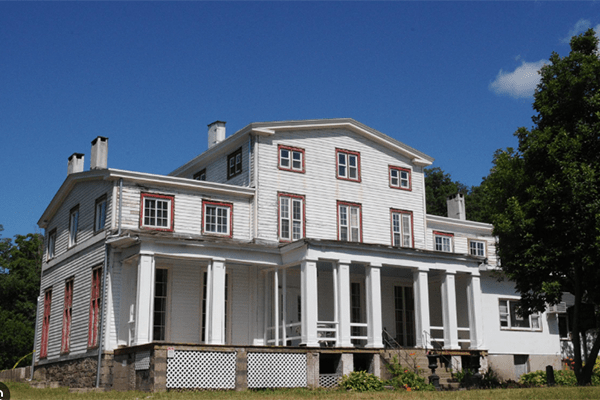|
RCBJ-Audible (Listen For Free)
|
Friends of Harmony Hall Do A Yeoman’s Job Of Preserving An Historic House Through Robust Public Programming
By Tina Traster
It would not be an exaggeration to say historic homes can seem like an endangered species – hard to hold onto, needing protection and advocacy, something we miss when we fail to protect them.
Rockland County is peppered with privately-owned historic houses people love and live in. What’s more in flux are historic homes that are either government-owned or those run by nonprofits that endeavor to maintain a legacy and put the house to the public good.
The nonprofit Friends of Harmony Hall has been restoring the historic Jacob Sloat House, originally called Harmony Hall, on Liberty Rock Road in Sloatsburg, The house, purchased by Ramapo in 2006, but run by the nonprofit Friends of Harmony Hall since 2007, has been offering a rich buffet of programming which spotlights the home, teaches history, and aids in fundraising.
Most recently, the nonprofit has been gifted a $100,000 grant in memory of Rockland County residents Joan K. and Ray E. Stout, Jr. that will be used to restore the front porch. Built in the late 1840s, the wooden house embodies the transition from the then waning Greek Revival style to the newer Picturesque and Italianate architecture.
The Jacob Sloat House was listed on the National Register of Historic Places in 2006. Friends of Harmony Hall was organized under a provisional charter issued by the New York State Board of Regents in 2007 in partnership with the Town of Ramapo. The joint partnership has been tasked to restore the house, document its history, and offer arts and educational activities.
The Jacob Sloat House, which sits on two acres of pastoral land, is a testament to historic preservation because many projects like this lose steam and fail.
The world of historic preservation is filled with good intentions – but breathing life into historic buildings, especially those with pedigree, requires a well-founded mission, funding, volunteers, and an ongoing vision. Perhaps the three best Rockland County examples of preservation are the Orangetown Historical Museum & Archives, housed in the town-owned Revolutionary Era DePew House and the 1832 Jacob Blauvelt House in New City, which is owned and operated by the Historical Society of Rockland County. Both have been preserved and operate as museums. Add to that Nyack’s Edward Hopper House, the county’s gem in terms of a house with a household name, the artist Edward Hopper.
Other historic houses, like the sandstone Seth House in Orangetown and the restoration of the pre-Revolutionary era Smith House (also known as Sidman Tavern) in Sloatsburg, have been beautifully preserved and incorporated into private housing developments.
In 2016, a citizens’ group tried to save the Abram Lent House, a Revolutionary Era Dutch sandstone house, but failed after the owner razed it for the expansion of a shopping center. In Nyack, a group has been toiling for years to revive the John Green House, another rare sandstone building, near the Hudson River. The group has relied on donations and fundraising and was recently awarded a $90,000 matching grant from the Office of Parks, Recreation and Historic Preservation for Phase III of the rehabilitation of the historic John Green House to rebuild the western wall of the 1819 house.
Three town government-owned houses – the Henry Varnum Poor House, the Traphagen House and the Budke House – all in Clarkstown though the Town of Ramapo owns the Poor House – are either in various states of decline or stagnation. None is serving the public robustly. The first two are used occasionally for seasonal festivals and the Poor House is a deteriorated relic that’s been sitting idle for years.
What sets the Jacob Sloat House apart is the energy, vitality and excellent programming that has kept the house on the radar and in the hearts of those who’ve attended the Victorian Holiday teas, the Highlands Bluegrass Music & Crafts Festival, the Grateful Dead Music Festival, the Great American Picnic, Roaring 20s Speakeasy, Garden Parties, and solstice events.
Staying relevant is part of keeping an historic house alive, as is the ability to raise money and secure grants. Rockland County has been recognizing Harmony Hall with its yearly tourism grants; in 2024, the Friends received $15,000 to promote The Highlands Bluegrass Festival, held in September, and for the Victorian Holiday in December.
“Over the years, the Friends have increased membership, events and attendance,” said Board of Trustee President Andrea LaMantia. “We have made Harmony Hall a year-round cultural resource with our signature events and the numbers of attendees rise every year.”
The $100,000 grant to restore the porch, along with $45,000 raised through donations, gets the organization three quarters of the way toward its goal to restore the porch. The organization is seeking another $45,000 for the $190,000 project.
“The porch is falling off the house,” LaMantia said. “It’s deteriorating, rotting, there’s a family of raccoons living under it.”
Speaking of families, it’s unclear where Harmony Hall would be today without the energy and passion of Peter Bush, the great-great-great grandson of Jacob Sloat, a descendant of village founder Stephen Sloat, who made a fortune as a textile merchant earlier in the century. In the early 1900s, the house passed through a variety of owners and uses, including two restaurants and a home for the elderly. When the home was shuttered, a developer submitted plans to build a dense dormitory for elder housing and proposed tearing down the original house. That’s when Bush and concerned citizens stepped up.
Through the years, it’s taken blood, sweat and tears to keep renovating the house, which is still not ready to be called a museum. Floors have been ripped up and replaced. An historic original staircase and windows have been unearthed. Volunteers have stepped in to help with peeling plaster that was eroding from years of neglect and water damage.
“We not only have renovated parts of the building, but we have put in heat, painted, and rewired and restored a chandelier that we found,” said LaMantia.
For now, the physical priority is to restore the front porch of the house, which sits atop a gentle rise leading up from the Ramapo River. What worries LaMantia the most is the advanced ages of the Friends’ board. For Harmony Hall to have a long life, it will need new blood, a younger generation to pass the mantle to.
“Harmony Hall was personal for Peter,” said LaMantia. “It really helps when you have a family that tries to keep a legacy alive. There’s a copy of a portrait of Jacob Bush that hangs in the house. It motivates us knowing that there’s still family here that continues to connect with other Sloats, who are part of America’s history. We are a significant part of American history.”














